Not all birds flying in the city are mayas. If you take a closer look, some of these small brown birds happen to be paddyfield pipits, which are songbirds, or brown shrikes, which have flown across the seas from northern Asian countries to avoid the winter season.
Frogs and lizards are not the only reptiles prevalent in the city, either. There are also worm snakes (don’t worry, they’re nonvenomous!) and sun skinks, which are shiny lizards.
If you haven’t noticed any of these, don’t worry. When you think of the habitat of exotic plants and animals, you rarely really picture the city. The only unusual animal breeds you expect to see in urban areas, after all, are the ones in zoos and sanctuaries, all kept for educational purposes. If not only for this campus-based wildlife project, we wouldn’t also notice the varying types of birds, reptiles, insects, and plants living within one of the busiest areas in the Metro.
The Ateneo Wild Project, which has been making rounds on social media since last August, sheds light on the “wide variety of wildlife” present within the Ateneo de Manila University campus along Katipunan Avenue in Quezon City.
Here’s a look at some of their posts:
https://www.facebook.com/theateneowild/photos/a.2224636541105980/2258144777755156/?type=3&theater
https://www.instagram.com/p/BpRLGaChK76/
https://www.instagram.com/p/BolJkQ1j3LX/
https://www.instagram.com/p/BoQ6OXSjY8R/
https://www.instagram.com/p/Bo8r9wplvKt/?utm_source=ig_web_copy_link
Look, they even found some crustaceans by the campus waterways:
Made to “instill an appreciation for urban biodiversity and the importance of green spaces in the city,” the project is spearheaded by faculty members Trinket Canlas Constantino and Abby Favis—from the Department of Biology and Department of Environmental Science, respectively. They use social media as a tool to “highlight campus biodiversity and to encourage citizen science.”
Constantino and Favis post photos and information of exotic living species seen on campus on their Facebook and Instagram pages. They either find some of these creatures themselves or let members of the Ateneo community submit photos and its location to them.
https://www.instagram.com/p/BpCFcC_BCvq/
“In a nutshell, our project started as a way to involve the community in achieving campus sustainability goals by reporting any wildlife they come across in the Ateneo campus,” the duo told Nolisoli.ph. They cull the information from “various sources [such as] our own experience, from scientific literature, from fellow nature enthusiasts and experts in respective fields of the natural sciences.”
The Ateneo Wild also conducts guided nature walks from time to time. Although this event is currently exclusive to the Ateneo community, Constantino and Favis hope to offer the walks to the external community soon.
Header image and photos used courtesy of The Ateneo Wild
Get more stories like this by subscribing to our weekly newsletter here.
Read more:
Foodies, please don’t eat endangered animals
This animal shelter won’t be able to feed their dogs and cats today
Wiji Lacsamana uses tattoo ink without animal fat
Read more by Amierielle Anne Bulan:
Congress is splitting Palawan into 3 provinces and locals aren’t happy about it
LOOK: Unconventional black house in Tagaytay is a home to 25 dogs
Instead of penalizing farmers, why not provide drying facilities?
Writer: AMIERIELLE ANNE BULAN




